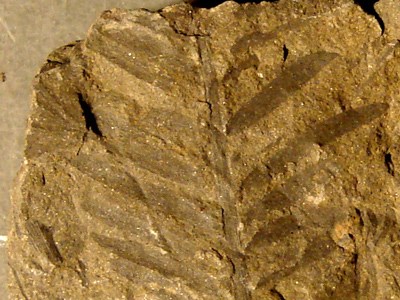
Photo by Rene Jakobson 
Photo by D. Sunderlin Identification Level: Genus and Phylum
Metasequoia is a genus. Cycadophyta and ginkgophyta are divisions (the plant-world word for phyla). Diverse plant material (cones, leaves and shoots) allowed referral to Metasequoia, one of eight different types of conifers identified from the Cantwell Formation to-date. Although some specimens of cycadophytes and ginkgophytes have been discovered in Denali, the preservation quality of the fossils makes it difficult to identify them more specifically.
Where do I live?
These large plants would have required a lot of water for survival. Not surprisingly, they lived in marshes, floodplain forests, and lake margins. Cycads tended to dominate marshy areas along with horsetails, while Metasequoia and ginkgophytes inhabited alluvial floodplains and slopes.
How do we know I lived in Denali?
Metasequoia shoots, seed cones, needles, and wood have been found near Sable Mountain in Denali. Fan-shaped fossil leaves of ginkgophyte plants have also been discovered in many locations. Several locations within the park have produced evidence of cycadophyte leaf fragments, which have distinctive parallel venation. In addition, a few pollen grains of ginkgophytes and/or cycadophytes have been found near Sable Mountain.
Fun Fact
The tree fossils discovered in Denali provide clues to a warmer and wetter Cretaceous environment, more like today’s temperate rain forests. In addition, the plants tell us what the dinosaurs were eating.The tree fossils discovered in Denali provide clues to a warmer and wetter Cretaceous environment, more like today's temperate rain forests. In addition, the plants tell us what the dinosaurs were eating.
|
Last updated: August 18, 2016
